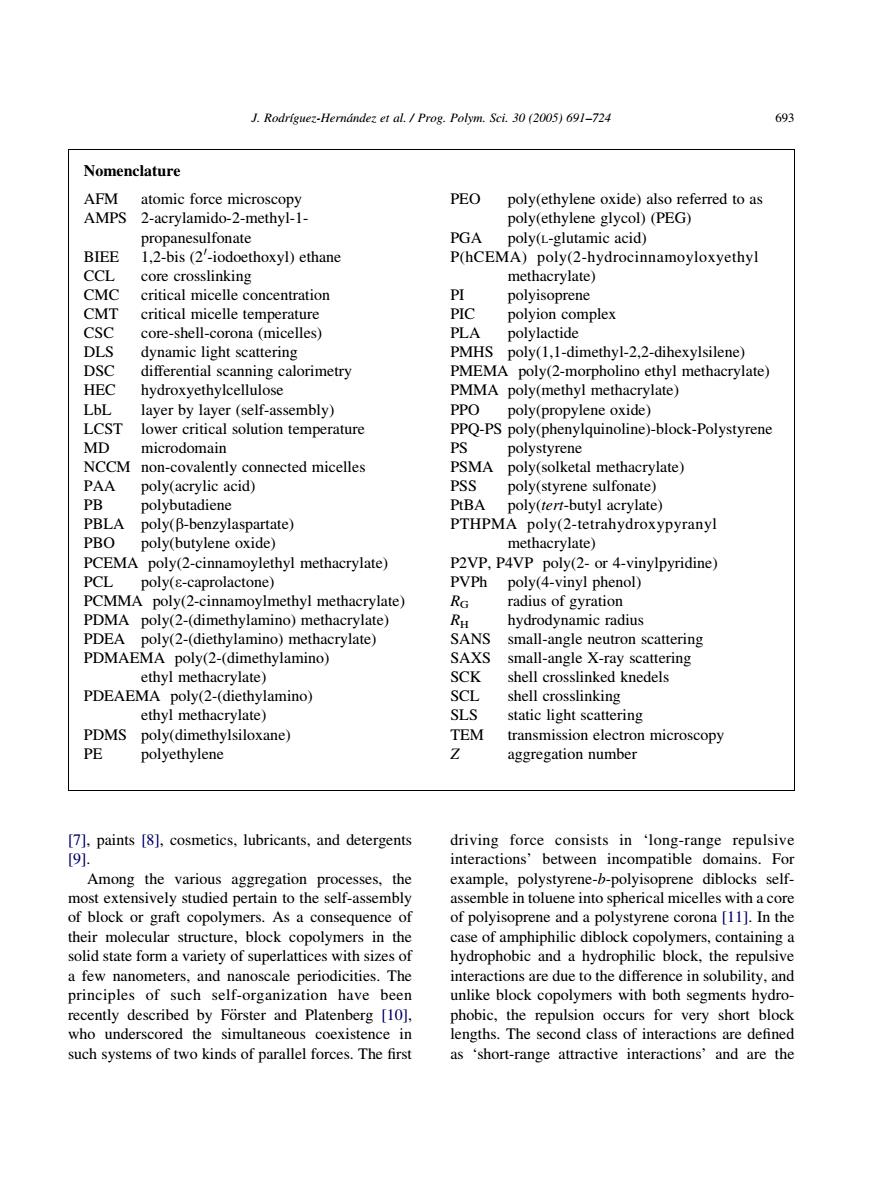正在加载图片...

J.Rodriguez-Hemdndez et al./Prog.Polym.Sci.30(2005)691-724 693 Nomenclature PEO poly(ethylene oxide)als BIEE amoyloxyethyl CCL core crosslinking critical micelle concentration PI polyisoprene CMT critical micelle temperature PIC polyion complex core-shell-corona (micelles) PLA polylactide DLS dynamic light scattering PMH poly(1.1-dimethyl-2.2-dihexylsilene) ino ethyl methacrylate) LCST ayer by pory(propy ature e)-block-Polystyren M microdomain rene NCCM non-covalently connected micelles PSMA poly(solketal methacrylate) PAA poly(acrylic acid) PSS poly(styrene sulfonate) P polvbutadiene PBA poly(tert-butyl acrylate) PBLA PTHPMA poly(2-tetrahydroxypyranyl PBO poly( ethyl methacrylate) poly(capo poly( myl phe thyl me late methacrylate) PDEA SANS small-angle neutron scattering PDMAEMA poly(2-(dimethylamino) SAXS small-angle X-ray scattering ethyl methacrylate) SCK shell crosslinked knedels PDEAEMA poly(2-(diethylamino) shell crosslinking ethyl methacrylate) static light scattering poly(dimethylsiloxane) transmission electron microscopy polyethylen aggregation numbe 7paints[cosmetics,lubricants,and detergents driving force consists in 'long-range repulsive interactions'between incompatible domains.For Among the various aggregation processes,the example,polystyrene-b-polyisoprene diblocks self- assemble in toluene into spherical micelles with acor or graft copolyme As a cons of polyisoprene ind a polystyrene corona [11].In the ar stru sin th 0 stat rm a van ety of supe hydrop an repul ce in se of are due to the nd Plat the who underscored the ths.The of int s are defined such systems of two kinds of parallel for es.The first short-range attractive intera tions'and are the [7], paints [8], cosmetics, lubricants, and detergents [9]. Among the various aggregation processes, the most extensively studied pertain to the self-assembly of block or graft copolymers. As a consequence of their molecular structure, block copolymers in the solid state form a variety of superlattices with sizes of a few nanometers, and nanoscale periodicities. The principles of such self-organization have been recently described by Fo¨rster and Platenberg [10], who underscored the simultaneous coexistence in such systems of two kinds of parallel forces. The first driving force consists in ‘long-range repulsive interactions’ between incompatible domains. For example, polystyrene-b-polyisoprene diblocks selfassemble in toluene into spherical micelles with a core of polyisoprene and a polystyrene corona [11]. In the case of amphiphilic diblock copolymers, containing a hydrophobic and a hydrophilic block, the repulsive interactions are due to the difference in solubility, and unlike block copolymers with both segments hydrophobic, the repulsion occurs for very short block lengths. The second class of interactions are defined as ‘short-range attractive interactions’ and are the Nomenclature AFM atomic force microscopy AMPS 2-acrylamido-2-methyl-1- propanesulfonate BIEE 1,2-bis (20 -iodoethoxyl) ethane CCL core crosslinking CMC critical micelle concentration CMT critical micelle temperature CSC core-shell-corona (micelles) DLS dynamic light scattering DSC differential scanning calorimetry HEC hydroxyethylcellulose LbL layer by layer (self-assembly) LCST lower critical solution temperature MD microdomain NCCM non-covalently connected micelles PAA poly(acrylic acid) PB polybutadiene PBLA poly(b-benzylaspartate) PBO poly(butylene oxide) PCEMA poly(2-cinnamoylethyl methacrylate) PCL poly(3-caprolactone) PCMMA poly(2-cinnamoylmethyl methacrylate) PDMA poly(2-(dimethylamino) methacrylate) PDEA poly(2-(diethylamino) methacrylate) PDMAEMA poly(2-(dimethylamino) ethyl methacrylate) PDEAEMA poly(2-(diethylamino) ethyl methacrylate) PDMS poly(dimethylsiloxane) PE polyethylene PEO poly(ethylene oxide) also referred to as poly(ethylene glycol) (PEG) PGA poly(L-glutamic acid) P(hCEMA) poly(2-hydrocinnamoyloxyethyl methacrylate) PI polyisoprene PIC polyion complex PLA polylactide PMHS poly(1,1-dimethyl-2,2-dihexylsilene) PMEMA poly(2-morpholino ethyl methacrylate) PMMA poly(methyl methacrylate) PPO poly(propylene oxide) PPQ-PS poly(phenylquinoline)-block-Polystyrene PS polystyrene PSMA poly(solketal methacrylate) PSS poly(styrene sulfonate) PtBA poly(tert-butyl acrylate) PTHPMA poly(2-tetrahydroxypyranyl methacrylate) P2VP, P4VP poly(2- or 4-vinylpyridine) PVPh poly(4-vinyl phenol) RG radius of gyration RH hydrodynamic radius SANS small-angle neutron scattering SAXS small-angle X-ray scattering SCK shell crosslinked knedels SCL shell crosslinking SLS static light scattering TEM transmission electron microscopy Z aggregation number J. Rodrı´guez-Herna´ndez et al. / Prog. Polym. Sci. 30 (2005) 691–724 693